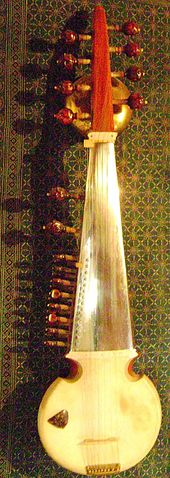Sarod
Sarod is one of the leading stringed instruments in classical North Indian music . The long-necked loud was in the 1860s in Lucknow from the Afghan Rubab and form elements of sursingar developed.
etymology
The Persian word sarod is much older than the Indian musical instrument. It is usually traced back to sorūd in the meaning of "song", "melody", "hymn" and further to the Persian verb sorūdan , which accordingly means "to sing", "to play a musical instrument", but also means "to poetry". It was perhaps carried over in the pronunciation variants surod, sorud and saroz on strings in the folk music of Balochistan , which are related to the sarinda . Sarod is sometimes further derived from shahrud ( šāh-rūd ), the name of a stringed instrument developed in the 10th century. This contains the two components šāh , ( Shah ), "king" and rūd , "string", in the approximate meaning "king of the sounds". In both derivations the word is in some way connected to music. The connection of sarod with sarad and saradiya vina ( Sanskrit "autumnal vina ") stated by the musicologist SM Tagore (Sourindramohan Tagore) in 1875 is now considered to be unfounded.
Design
The back of the sarod is carved out of one piece. The material used is either tun (Indian mahogany) or teak . The body is covered with a goat skin. The fretless fingerboard is made of metal. The sarod is strung with 25 metal strings. Three of these are rhythm strings, four of them are used as melody strings. The grip hand shortens these melody strings - in contrast to most stringed instruments - with the help of the fingernail. The melody and rhythm strings are struck with a coconut shell pick ( jaba ). They are stretched over a thin horn bridge . The remaining strings serve as sympathetic strings and run through a recess in the bridge. The neck has a polished steel plate as a fingerboard. An additional sound box is attached to the end of the neck.
Style of play
The teaching tradition of the Senia Gharanas , music schools or styles that trace their origins back to the important musician Mian Tansen in the 16th century, included teaching the long-necked vina and the bowl- necked lute rubab in addition to vocal training . The traditional Dhrupad tradition was largely passed on within the respective families, mostly from father to son. Outsiders only taught the music teachers in the less strict khyal singing style and on the lute instruments sitar , sursingar and sarod . A distinction is made between four sarod gharanas: the Shahjahanpur gharana cultivated by Muslim families , the Lucknow gharana and the Gwalior gharana, and the Maihar gharana founded by Allauddin Khan , a Hindu musician .
The most famous sarod player of the 20th century was Ali Akbar Khan . He died in San Francisco in 2009 and was in the Maihar Gharana tradition . Others are: Amjad Ali Khan , Radhika Mohan Maitra (1917–1981) and his students Buddhadev Das Gupta , Jai Uttal , Hafiz Ali Khan, Partho Sarathy, Rajeev Taranath , Tejendra Majumdar , Aashish Khan , Ayaan Ali Khan , Amaan Ali Khan , Basant Kabra, Biswajeet Roy Chowdhury, Brij Narayan , Devjyoti Bose, Kalyan Mukherjee, Ken Zuckerman , Wajahat Khan, Zarin Daruwala, Ranajit Sengupta, Sharan Rani and Vikash Maharaj.
literature
- Allyn Miner: Sitar and Sarod in the 18th and 19th Centuries. Florian Noetzel Verlag, Wilhelmshaven 1993
- Adrian McNeil: Inventing the Sarod: A Cultural History. Seagull Books, Calcutta 2004
Web links
Individual evidence
- ^ Heinrich FJ Junker , Bozorg Alavi : Persian-German dictionary . Leipzig / Tehran 1970, p. 420.
- ^ Adrian McNeil: Inventing the Sarod: A Cultural History . Seagull Books, Calcutta 2004, p. 27, ISBN 978-81-7046-213-2 ; previously at Henry George Farmer : Studies in Oriental Music. The Civic Press, Glasgow 1939, p. 258
- ↑ Luth "vina saradiya". Europeana Collections (image)
- ^ Alastair Dick: Sarod In: Laurence Libin (Ed.): The Grove Dictionary of Musical Instruments. Vol. 4, Oxford University Press, Oxford / New York 2014, p. 389
- ↑ Masakazu Tamori: The Transformation of Sarod Gharana: Transmitting Musical Property in Hindustani Music. ( Memento of the original from July 22, 2011 in the Internet Archive ) Info: The archive link was inserted automatically and has not yet been checked. Please check the original and archive link according to the instructions and then remove this notice. (PDF; 489 kB) Senri Ethnological Studies 71, 2008, pp. 169–202, here p. 175

